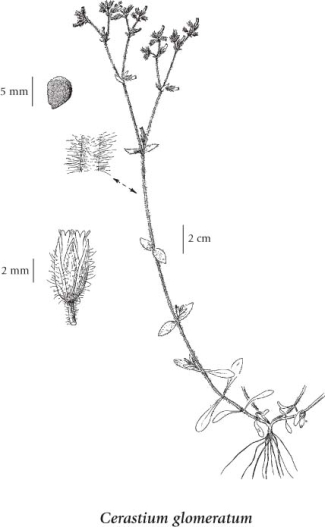Cerastium glomeratum Thuill.
sticky chickweed
Caryophyllaceae (Pink family)
Introduction to Vascular Plants
sticky chickweed
Caryophyllaceae (Pink family)
Introduction to Vascular Plants
Species Information
General:
Annual herb from a slender taproot; stems decumbent to erect, usually dichotomously branched, very hairy, sticky, 5-50 cm tall/long.
Leaves:
Basal leaves lacking; stem leaves opposite, pale yellowish-green, spoon-shaped to egg-shaped, 3-20 mm long, 2-10 mm wide, 1-nerved, slightly hairy above and below; upper stem leaves larger, to 25 mm long and 15 mm wide, egg-shaped; stipules lacking.
Flowers:
Inflorescence numerous in a crowded cluster; flower stalks shorter than sepals; petals 5, white, 3-5 mm long, deeply bilobed; sepals 5, narrowly egg-shaped, 3-5 mm long, stiff-hairy and more or less glandular.
Fruits:
Capsules cylindric, 6-9 mm long, 10-valved; seeds pale brown, 0.3-0.5 mm long, finely pimply.
Illustration

If more than one illustration is available for a species (e.g., separate illustrations were provided for two subspecies) then links to the separate images will be provided below. Note that individual subspecies or varietal illustrations are not always available.
Illustration Source: The Illustrated Flora of British Columbia
Ecology
Ecological Framework for Cerastium glomeratum
The table below shows the species-specific information calculated from
original data (BEC database) provided by the BC Ministry of Forests and Range.
(Updated August, 2013)
The table below shows the species-specific information calculated from
original data (BEC database) provided by the BC Ministry of Forests and Range.
(Updated August, 2013)
| Site Information |
Value / Class |
||
|
Avg |
Min |
Max |
|
| Elevation
(metres) |
1350 | 1350 | 1350 |
| Slope
Gradient (%) |
25 | 25 | 25 |
|
Aspect (degrees) |
35 | 35 | 35 |
| Soil
Moisture Regime (SMR) [0 - very xeric; 4 - mesic; 8 - hydric] |
3 | 3 | 3 |
| Modal
Nutrient Regime
Class |
B | ||
| #
of field plots species was recorded in: |
1 | ||
| Modal
BEC Zone Class |
MS | ||
|
All BEC Zones (# of stations/zone) species was recorded in |
MS(1) | ||
|
Source:
Klinkenberg 2013
|
|||
Habitat and Range
Mesic to dry roadsides, waste places, lawns and pastures in the lowland, steppe and lower montane zones; common in SW BC, rare elsewhere in S BC and the Queen Charlotte Islands; introduced from Eurasia.Status Information
Synonyms
Synonyms and Alternate Names:
Cerastium acutatum Suksdorf
Cerastium glomeratum var. apetalum (Dumort.) Fenzl
Cerastium viscosum